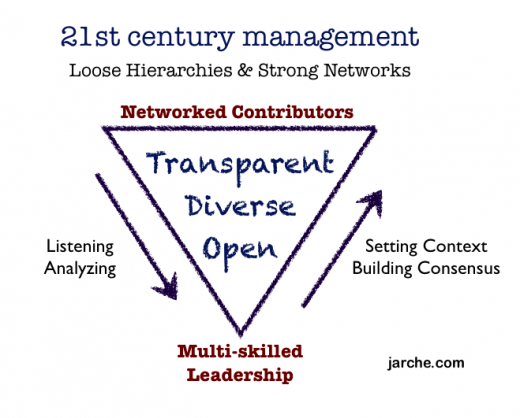The five informal learning methods described in yesterday’s post on Learning in the Workplace have one thing in common. They are all relatively simple.

Most of today’s larger companies have a complicated structure. Over time, to enable growth and efficiencies, more processes have been put in place. New layers of control and supervision continue to appear, silos are created, and knowledge acquisition is formalized in an attempt to gain efficiency through specialization. As companies get bigger, internal growth and innovation reach a tipping point, and companies rely on mergers and acquisitions to maintain the illusion of growth.
But knowledge, and the acquisition of new knowledge, are still key factors for innovation and effectiveness. To compensate for its complicated processes, the enterprise attempts to shift to another paradigm, and tries to become a learning organization, putting significant effort into training. Unfortunately, training is often not the right solution.

Today’s large, complicated organizations are now facing increasingly complex business environments that require agility in simultaneously learning and working. Typical strategies of optimizing existing business processes or cost reductions only marginally influence the organization’s effectiveness. Faster evolving markets challenge the organization’s ability to react to customer demand. Decision-making becomes paralyzed by process-based operations and chains of command and control; thereby decreasing agility. Training, as “the” solution to workplace learning needs, fails to deliver and then gets marginalized, often being the first department to have its budget cut.
Organizations (and training departments) need to understand complexity, instead of simply increasing complication. This lack of understanding is a major barrier to adopting social business concepts and practices. We should always take into consideration that people can handle complexity much better than our constructed systems can.
We need to think of organizations as parts of Value Networks.
We need to move away from shareholder value and become client-focused
We need to base growth on cultivating ecosystems, not the illusion of mergers and acquisitions.
We need to think of knowledge acquisition and sharing as social.
We need to constantly develop emergent practices.
All of these changes can be started by doing a few simple things. As with Lego bricks, using a single unifier (the pin size) we can create an infinite variety of solutions. The examples of how to support informal learning do not require expensive technology or detailed needs analyses. They can be implemented quickly and modified over time. For too long our organizations have suffered from the disease of complication. It’s time to simplify.











